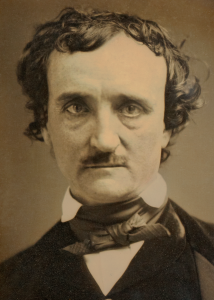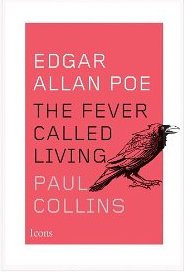A drunkard. A poet. An editor. A reporter. A military man. An orphan. A lecturer. The father of the detective novel. The Shakespeare of America. A slanderer and libeler. The husband of a 13-year-old bride.
And a writer. Above all, a writer.

Questions and mystery surrounded Poe’s own life and death, and continue even today – we may never know who left three roses and a bottle of cognac on his grave in Baltimore for decades until 2011 (alas, the “Poe Toaster” disappeared or died, to be seen nevermore).
Poe has often been the subject of biographers and literary criticism. Now we have a new one, Edgar Allan Poe: The Fever Called Living, by Paul Collins, associate professor of English at Portland State University. This is not an exhaustive biography (117 pages, including appendices), but it is compact, succinct, and covers the main events of Poe’s life along with his literary works. It’s a fine introduction to an iconic American writer.
The book is all of five chapters, covering Poe’s early life with his theatrical parents and the well-to-do foster family he landed with; how and why he began to write; his years as a reporter and editor; how “The Raven” established him as a literary light; the highs and lows of his career (more a series of rises and falls over his working life); and then an almost surprising decline just as he was finally coming into his own.
Along the way, we find Walt Whitman, Henry Wadsworth Longfellow, James Fenimore Cooper, Washington Irving, William Cullen Bryant, Nathaniel Hawthorne, Herman Melville, and others. Collins places Poe in his cultural and literary context, providing a window into the literature of the 19th century.

The biography does not include the full texts of any of Poe’s poems, but it does account for how the major works came to be written (and often reprinted without paying the author; such was the state of copyright laws at the time). Here’s a poem by Poe that is representative of much of the poetry he wrote.
A Dream
In visions of the dark night
I have dreamed of joy departed—
But a waking dream of life and light
Hath left me broken-hearted.
Ah! what is not a dream by day
To him whose eyes are cast
On things around him with a ray
Turned back upon the past?
That holy dream—that holy dream,
While all the world were chiding,
Hath cheered me as a lovely beam
A lonely spirit guiding.
What though that light, thro’ storm and night,
So trembled from afar—
What could there be more purely bright
In Truth’s day-star?
Edgar Allan Poe: The Fever Called Living is an excellent introduction to a great American writer.
Related:
Paul Collins’ web site: The Literary Detective
Featured photo by Daniele Zedda, Creative Commons, via Flickr. Post by Glynn Young, author of the novels Dancing Priest and A Light Shining, and Poetry at Work.
Want to brighten your morning coffee?
Subscribe to Every Day Poems and find some beauty in your inbox.
- Poets and Poems: Katie Kalisz and “Flu Season” - April 15, 2025
- Poets and Poems: Michelle Ortega and “When You Ask Me, Why Paris?” - April 10, 2025
- Robert Waldron Imagines the Creation of “The Hound of Heaven” - April 8, 2025

Marcy says
Glynn Young,
Just finished reading your article on Poe, this was the first time I realized he had a 13 year old bride. Mystery, everyone loves one and Poe had his share. You also bought up Nathaniel Hawthorne, seeing the House of Seven Gables was such an experience. The hidden upper room was so small and I don’t like close places. So once everyone saw it I raced up there and ran through and back down the stairs. They all laughed at me being in my thirties at the time. The poem you choose was lovely, “What though that light, thro’ storm and night, so trembled from afar. Very good Glynn, I enjoyed the dark moment and excellent read.